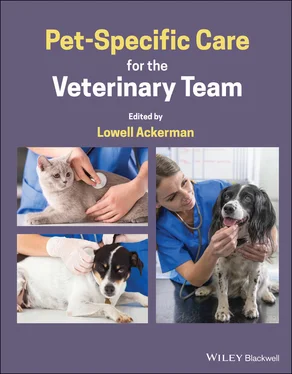| INFORMATION TO BE PROVIDED BY SELLER |
| Name of Business: Website:Address: Telephone:Name of Dog (Registered):Date of Birth: Weight: □ kg □ lb Color:Identification: Microchip __________ Tattoo ________________ Collar/Tag ____________Registration (e.g., AKC, UKC, CKC, etc.):□ Show Quality □ Pet Quality □ Breeding □ Nonbreeding |
| Question |
Yes |
No |
Don't know |
Documents provided |
| Did parents have prebreeding health screening? |
|
|
|
|
| Are parents' health screens in a public registry? |
|
|
|
|
| Are this animal's health screens in a public registry? |
|
|
|
|
| Has this animal had genetic health screening? |
|
|
|
|
| Have parents had genetic health screening? |
|
|
|
|
| Has this animal received regular veterinary evaluations? |
|
|
|
|
| Any irregularities determined by veterinary evaluations? |
|
|
|
|
| Are all vaccinations current? |
|
|
|
|
| Any exposure to infectious diseases? |
|
|
|
|
| Is recent parasite evaluation available? |
|
|
|
|
| Is this animal currently free of parasites? |
|
|
|
|
| Is this animal on integrated parasite control? |
|
|
|
|
| Any evidence of problem behaviors in this animal? |
|
|
|
|
| Is there a history of problem behaviors in the family? |
|
|
|
|
| Any evidence of allergies in this animal? |
|
|
|
|
| Is there a history of allergies in the family? |
|
|
|
|
| Has this animal been evaluated for orthopedic disorders? |
|
|
|
|
| Have parents been evaluated for orthopedic disorders? |
|
|
|
|
| Is this animal free of congenital heart diseases? |
|
|
|
|
| Are both parents free of heritable heart diseases? |
|
|
|
|
| Is this animal free of heritable eye diseases? |
|
|
|
|
| Are both parents free of heritable eye diseases? |
|
|
|
|
| Any evidence of hypothyroidism in this animal? |
|
|
|
|
| Is there any history of hypothyroidism in the family? |
|
|
|
|
| Any evidence of diabetes mellitus in this animal? |
|
|
|
|
| Any evidence of diabetes mellitus in the family? |
|
|
|
|
| Any evidence of seizure disorders in this animal? |
|
|
|
|
| Any evidence of seizure disorders in the family? |
|
|
|
|
| Any evidence of bleeding disorders in this animal? |
|
|
|
|
| Any evidence of bleeding disorders in the family? |
|
|
|
|
| Any evidence of cancer in this animal? |
|
|
|
|
| Any evidence of cancer in the family? |
|
|
|
|
| Medical‐behavioral money‐back guarantee provided? |
|
|
|
|
| Signature: Date: |
Unfortunately, this is not the way the situation typically evolves, so the veterinary team and client are sometimes engaged in an almost adversarial relationship in trying to determine how best to deal with the current situation. It is a much more positive relationship when the veterinary team acts as the client advocate, but for that to happen, such teams need to assume a much more proactive role in the acquisition of pets (see 5.7Preadoption Counseling).
Preselection counseling is not only medically relevant, but it also makes good business sense. In the United States, more dogs and cats are euthanized for behavioral reasons than for all medical causes combined [2]. Accordingly, helping prospective pet owners understand the ramifications of pet ownership before they actually take on the responsibility of pet ownership is in everyone's best interest.
 EXAMPLES
EXAMPLES
Mrs Stewart came to visit ABC Veterinary Hospital after hearing from a friend that the hospital offered preadoption counseling. She and her husband had a 4‐year‐old child, and they were thinking of getting a Siberian husky (they had seen a cute puppy of this breed in the pet store, but resisted the temptation to buy it at that time). From the selection counseling session, it was determined that the Stewarts lived in a two‐bedroom apartment, both adults worked long hours, and their lifestyle was decidedly sedentary between work and childrearing. By the end of the session, Mrs Stewart had acknowledged that a Siberian husky might not be the best breed for their circumstances and narrowed their choices to a miniature schnauzer or a bichon frisé and would make the final decision with her husband while armed with the breed information provided.
A staff member also provided some resources for finding an appropriate dog of either breed, including local breed rescue, online breed‐specific adoptions, and a list of breeders available from a national breeders' registry. The hospital provided a frequently asked questions (FAQ) document regarding pet adoption and basic care, forms for the prospective puppy seller to complete, and forms the practice would need once the final decision was made. A new puppy kit was provided, along with a container that the owner would use to bring a fecal sample on the first actual visit. Mrs Stewart was also invited to visit the Thursday evening “puppy kindergarten” class that was offered by one of the technicians, and they would introduce her to their basic temperament‐testing regimen and go over the socialization and training classes offered. A quick introduction was made to Dr Smith, whom she would see at the first scheduled visit, and she was invited to call back with any other questions. Mrs Stewart was assured that although it wasn't quite as involved as raising a baby, ABC Veterinary Hospital would be there to help her through the process every step of the way. The client‐to‐be left the practice armed with a much better understanding of dog ownership and with an already considerable loyalty to ABC Veterinary Hospital.
About three weeks later, Mrs Stewart came in with Schnitzel, an 8‐week‐old miniature schnauzer, and dutifully brought in a fecal sample in the container previously provided. Schnitzel was a fine, healthy specimen, with only a minor umbilical hernia that could be fixed at time of neutering. Mrs Stewart had read most of the material provided and had some questions about which pet health insurance plan might be best for Schnitzel. Dr Smith started Schnitzel on a sensible dietary regimen and reiterated some of the breed concerns, such as pancreatitis and calcium oxalate urolithiasis. Discussions about vaccination schedules, genetic screening, parasite control, nutrition, and proper socialization ensued, and then the long‐term healthcare plan was reviewed.
 TAKE‐AWAYS
TAKE‐AWAYS
Читать дальше

 EXAMPLES
EXAMPLES TAKE‐AWAYS
TAKE‐AWAYS










